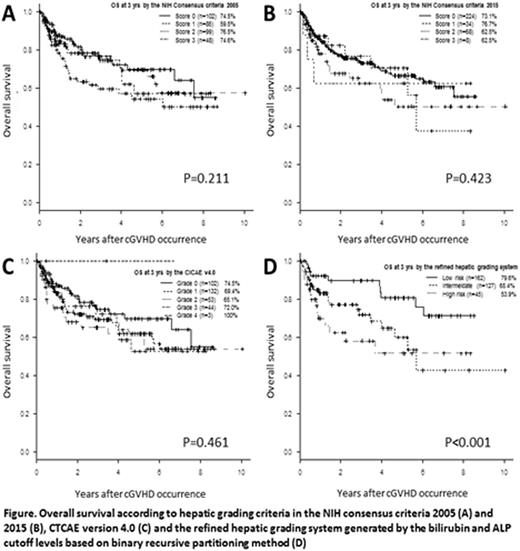Abstract
Background: Chronic GVHD (cGVHD) is a syndrome with diverse clinical features resembling autoimmune disorders. cGVHD affects long-term outcomes of allogeneic HCT, resulting in significant morbidity and mortality. Scoring the severity of cGVHD has been proposed with recent changes in the grading system of cGVHD based on the NIH consensus criteria (NCC) in 2015. Grading of liver GVHD is based on the severity of liver enzyme elevation both in NCC in 2005 and 2015. The cutoff of liver enzyme profiles for liver GVHD grading is arbitrarily determined but never been validated. In this study we attempted to evaluate 3 grading systems of hepatic parameters used in 1) NCC 2005, 2) NCC 2015, and 3) the common terminology criteria for adverse events (CTCAE) version 4.0. We also have adopted binary recursive partitioning (rpart) to define the optimal cut-off that provides the best risk stratification to overall survival (OS) after development of cGVHD.
Methods: A retrospective review was conducted to compare the hepatic grading systems using liver enzyme parameters used in NCC 2005, NCC2015 and CTCAE v4.0. We reviewed 336 patients who developed cGVHD after allogeneic HCT performed between 2002 and 2014. Long-term outcomes including OS and non-relapse mortality (NRM) after the occurrence of cGVHD were analyzed using the 3 hepatic grading systems. Using rpart, we determined the optimal value for each component of the liver enzyme profile (i.e. AST, ALT, ALP and bilirubin level) was which could identify the best risk stratification of OS. A refined hepatic grading system was generated based on the cut off of ALP and bilirubin level proposed by rpart method, which divided the patients into three groups: low (bilirubin <14 mmol/L and ALP < 146 IU/L), intermediate (bilirubin level ≥14 mmol/L or ALP ≥ 146 IU/L) and high risk (both) . OS and NRM were also compared according to the refined hepatic grading system.
Results: Out of 336 patients, 181 had liver involvement of cGVHD. The 3 year OS rate was 74.9% (66.7-81.3%) in the group developing liver GVHD, while that was 67.0% (57.7-74.7%) in the group without liver GVHD (p=0.629). There is no difference of non-relapse mortality (NRM) between patients with or without liver GVHD (14.4% vs. 17.2%; p= 0.661).
In the patients developing liver GVHD, 3 hepatic grading systems were evaluated with respect to OS and NRM after onset of cGVHD. None of the 3 grading systems could stratify the patients statistically according to OS (p=0.211 for NCC 2005; p=0.423 for NCC 2015; p=0.461 for CTCAE4.0) or to NRM (p=0.615 for NCC 2005; p=0.327 for NCC 2015; p=0.941 for CTCAE v4.0). Using rpart, we found that 1) bilirubin level ≥14 mmol/L (p=0.01) and 2) ALP ≥ 146 IU/L (p=0.059) are associated with shorter OS, 2) AST and ALT levels were not associated with OS or NRM.
A refined hepatic grading system was generated with assignment of a score to each risk factor. A score of 1 was assigned to bilirubin ≥14 mmol/L and ALP ≥ 146 IU/L, each. Total score was calculated with risk score 0 (n=54, 30.0%), risk score 1 (n=85, 57.2%) and risk score 2 (n=41, 22.8%). This hepatic grading system could stratify the patients according to their OS (p=0.015): 89.6% in low vs. 71.8% in intermediate vs. 58.0% in high risk group after onset of cGVHD.
Then, we have applied the refined hepatic grading system into all 336 patients developing cGVHD regardless of organ involvement. As expected, the hepatic grading system can stratify 336 patients according to OS: 79.6% in low vs. 65.4% in intermediate vs. 53.9% in high risk group after onset of cGVHD (p=0.001); according to NRM: 11.9% in low vs. 17.2% in intermediate vs. 26.1% in high risk group after onset of cGVHD (p=0.089).
Multivariate analysis was performed including 9 covariates including refined hepatic grading system, liver involvement of cGVHD, cGVHD subtype, cGVHD onset < 5 months, age (by decade), platelet counts, HLA match, gender mismatch, and T cell depletion, and confirmed that the refined hepatic grading system is an independent prognostic factor for OS (p=0.003, HR 0.491) in addition to cGVHD onset <5 months and HLA match.
Conclusions: None of hepatic grading systems could stratify the patients according to OS/NRM after development of cGVHD. The refined hepatic grading system using bilirubin ≥14 mmol/L and ALP ≥ 146 IU/L at onset of cGVHD defined by the rpart method, could improve risk stratification of the patients developing cGVHD.
No relevant conflicts of interest to declare.
Author notes
Asterisk with author names denotes non-ASH members.


